May 9, 2025 | 21:00 GMT +7
May 9, 2025 | 21:00 GMT +7
Hotline: 0913.378.918
May 9, 2025 | 21:00 GMT +7
Hotline: 0913.378.918

Tea cultivation provides jobs and income for millions of households. Photo: Hoang Anh.
Vietnam ranks as the world’s seventh-largest tea producer and fifth-largest exporter, with around 123,000 hectares under cultivation and annual export earnings exceeding USD 230 million. The tea sector not only contributes to economic growth but also plays a vital role in generating rural employment, stabilising communities, and supporting environmental protection, particularly in the northern mountainous regions.
According to Dr Luu Ngoc Quyen, Director of the Northern Mountainous Agriculture and Forestry Science Institute (NOMAFSI), scientific and technological advances have been a driving force behind the sector’s success. Over the past two decades, NOMAFSI has led efforts in conserving tea genetic resources, developing new cultivars, promoting sustainable cultivation, and modernising processing methods. These advances have enabled Vietnam to maintain stable tea-growing areas while doubling average yields from 5 tonnes per hectare in 2005 to nearly 10 tonnes per hectare by 2024.

Tea harvesting in Suoi Giang, Yen Bai. Photo: Hoang Anh.
One of NOMAFSI’s notable achievements is the conservation and development of native Shan tea varieties. In Ha Giang province, 105 ancient shan tea trees were selected as elite specimens, leading to over 1,300 being recognised as National Heritage Trees. This not only preserves biodiversity but also provides a foundation for cultural tourism. The institute also helped establish a 35-hectare organic production zone and developed the protected “Lung Phin Green Tea” brand, linking Shan tea production with regional eco-tourism.
Regarding varietal development, NOMAFSI currently manages 406 tea genetic resources and has created a 31.3-hectare mother plant garden for 17 new tea cultivars. Among these are Huong Bac Son, LCT1, PH8, VN15, and Kim Tuyen—high-yielding, quality-driven varieties suited to green tea, oolong, black tea, and matcha processing. As a result, the share of tea land using new cultivars has risen from 15% in 2000 to nearly 70% by 2024, helping producers diversify their offerings and meet market demands more effectively.

New tea varieties have doubled yields, from 5 tonnes per hectare in 2005 to nearly 10 tonnes per hectare in 2024. Photo: Hoang Anh.
Beyond genetic improvement, NOMAFSI has strongly emphasized sustainable tea cultivation practices and technical transfer. Through collaborative efforts with local farmers and businesses, the Institute has introduced advanced cultivation protocols that reduce chemical inputs, enhance soil health, and improve the quality of fresh tea leaves.
In 2023, the Department of Crop Production (now Department of Crop Production and Plant Protection) officially recognised three major technical advances developed by NOMAFSI: the production protocols for matcha-grade raw material using PH8 and LCT1; for oolong tea using Huong Bac Son; and for high-end green tea using VN15 and PH14. These techniques have been successfully implemented across over 50 hectares in Phu Tho, Tuyen Quang, and Lai Chau provinces, forming integrated value chains for high-quality fresh tea production.
On the processing side, NOMAFSI has worked extensively to refine technologies tailored to new cultivars. Several of these innovations have been officially recognised as technical advances, including the processing of oolong tea from Huong Bac Son, specialty green tea from VN15 and PH14, and matcha powder from LCT1 and PH8. These processes have been widely transferred to companies and cooperatives across Vietnam. Notably, enterprises such as The He Moi Company and Kia Tang Mountain Tea JSC have reported economic efficiency gains of 35–40%, while others like Asia Tea Company, Dong Truong Son Clean Tea Cooperative, and Phu Thinh Cooperative have achieved price increases of over 20% for their processed products compared to similar teas using older methods.

Tea plants in Tan Cuong, Thai Nguyen province. Photo: Hoang Anh.
NOMAFSI has also collaborated on regional development initiatives, such as revitalising the Doong Pan tea-growing area in Cao Bang province and supporting the development of OCOP-certified green tea products. The Institute’s new processing technologies have been adopted in multiple provinces—Phu Tho, Bac Kan, Yen Bai, Nghe An, Ha Giang, Son La, and Kon Tum—contributing to product diversification. These include innovations in producing floral-scented teas, herbal teas, compressed cakes, Bi Luo Chun-style green teas, and ready-to-drink bottled tea beverages, particularly matcha.
Looking to the future, Dr Luu Ngoc Quyen outlines several key strategic directions for sustaining momentum in the tea sector. First, he calls for continued investment in preserving and utilising native shan tea resources, while expanding organic cultivation zones and developing cultural tea tourism. Second, he emphasises the need to build multi-value tea production models based on circular agriculture and traceability, linking processors closely with designated raw material zones. Third, he advocates for deeper processing and diversification of tea products, including green teas, oolong, matcha, and tea-based beverages to boost economic returns. Finally, he proposes the implementation of a national product programme, “High-Quality Vietnamese Tea”, aimed at strengthening the brand identity of Vietnamese tea on the international stage and affirming its reputation for both heritage and innovation.
Through science-led approaches, Vietnam’s tea industry is being redefined—not just as a traditional agricultural sector but as a modern, integrated value chain with potential to compete globally. NOMAFSI’s contributions exemplify how targeted research, innovation, and collaboration can drive sustainable transformation in a sector deeply rooted in both culture and livelihood.
Translated by Huong Giang

(VAN) Sugar beets and spinach are the best vegetables to grow during a nuclear winter, a new study suggests, while wheat and carrots are recommended for industrial production.

(VAN) The conservation of livestock and aquaculture genetic resources has been identified as a strategic task, requiring close coordination between research institutions and businesses.

(VAN) From May 6 to 8, the city of Italy, Rimini, hosted the international agricultural fair Macfrut 2025, where Son La province exhibited three OCOP specialities from Thuan Chau district.
![Multi-channel, multi-directional Vietnamese agricultural markets: [2] Trailblazing protocols](https://t.ex-cdn.com/nongnghiepmoitruong.vn/608w/files/linhnhp/2025/05/08/c3c6a2dc935f35016c4e-072943_81-073836-211134_854-082230-0924420.jpg)
(VAN) Vietnam and China have been accelerating agricultural trade cooperation, clearly demonstrating a mutual desire for win-win collaboration amid a complex international environment.

(VAN) In 2024, green investment from the private sector in Vietnam reached USD 161 million, accounting for approximately 2% of the total investment by the SEA-6 group: Indonesia, Malaysia, the Philippines, Singapore, Thailand, and Vietnam.
/2025/05/07/1651-1-190732_655.jpg)
(VAN) ‘After being disseminated and encouraged, I realized it was necessary to return them to nature,’ shared Mr. Do Van Vuong, a legal bear farmer in Yen Bai.